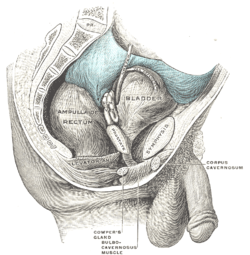- Rectoprostatic fascia
-
Rectoprostatic fascia 
Rectoprostatic fascia Latin fascia rectoprostatica The rectoprostatic fascia is a membranous partition at the lowest part of the rectovesical pouch. It separates the prostate and urinary bladder from the rectum.[1] It consists of a single fibromuscular structure with several layers that are fused together and covering the seminal vesicles. It is also called Denonvilliers' fascia after French anatomist and surgeon Charles-Pierre Denonvilliers.[2]
The structure corresponds to the rectovaginal fascia in the female. In post-operative transsexual women, the vaginal cavity is created along it.[3] The retroprostatic fascia also inhibits the posterior spread of prostatic adenocarcinoma; therefore invasion of the rectum is less common than is invasion of other contiguous structures.
References
List of muscles of abdominopelvic cavity (TA A04.5, GA 4.408) Abdomen/
wallAnterior/
lateralMuscleFasciaFascia/abdominal fascia: panniculus adiposus (Fascia of Camper) · stratum membranosum (Fascia of Scarpa) · Transversalis fascia (Interfoveolar ligament)
Linea alba · Linea semilunaris · Inguinal triangle
Inguinal canal (Deep inguinal ring, Superficial inguinal ring, Intercrural fibers, Crura of superficial inguinal ring)
Inguinal ligament (Pectineal ligament, Lacunar ligament, Reflected ligament)PosteriorMuscleFasciaPelvis MuscleFasciafascia/pelvic fascia visceral (Rectovaginal fascia, Rectoprostatic fascia) · parietal (Obturator fascia/Tendinous arch, Piriformis fascia)
floor/diaphragm: Superior fascia of pelvic diaphragm (Pubovesical ligament, Puboprostatic ligament) · Inferior fascia of pelvic diaphragm
Anococcygeal body
This anatomy article is a stub. You can help Wikipedia by expanding it.
